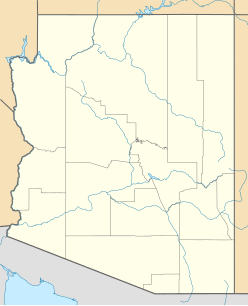
Back فوهة بارينجر Arabic Arizona krateri Azerbaijani Арызонскі кратар Byelorussian Арызонскі кратэр BE-X-OLD Метеоритен кратер на Барингер Bulgarian Meteor Crater Catalan Meteor Crater CEB Meteor Crater Czech Barringerkrateret Danish Barringer-Krater German
| Meteor Crater | |
|---|---|
 Meteor Crater | |
| Impact crater/structure | |
| Confidence | Confirmed[1] |
| Diameter | 0.737 miles (1.186 km) |
| Depth | 560 feet (170 m) |
| Rise | 148 feet (45 m) |
| Impactor diameter | 160 feet (50 m) |
| Age | 50,000 years |
| Exposed | Yes |
| Drilled | Yes |
| Bolide type | Iron meteorite |
| Location | |
| Location | Coconino County |
| Coordinates | 35°01′41″N 111°01′24″W / 35.02806°N 111.02333°W |
| Country | United States |
| State | Arizona |
| Access | Interstate 40 |
| Designated | November 1967 |
Meteor Crater, or Barringer Crater, is an impact crater about 37 mi (60 km) east of Flagstaff and 18 mi (29 km) west of Winslow in the desert of northern Arizona, United States. The site had several earlier names, and fragments of the meteorite are officially called the Canyon Diablo Meteorite, after the adjacent Canyon Diablo.[2]
Meteor Crater lies at an elevation of 5,640 ft (1,719 m) above sea level.[3] It is about 3,900 ft (1,200 m) in diameter, some 560 ft (170 m) deep, and is surrounded by a rim that rises 148 ft (45 m) above the surrounding plains. The center of the crater is filled with 690–790 ft (210–240 m) of rubble lying above crater bedrock.[1] One of the features of the crater is its squared-off outline, believed to be caused by existing regional jointing (cracks) in the strata at the impact site.[4]
Despite an attempt to make the crater a public landmark,[5] the crater remains privately owned by the Barringer family to the present day through their Barringer Crater Company. The Lunar and Planetary Institute, the American Museum of Natural History, and other science institutes proclaim it to be the "best-preserved meteorite crater on Earth".[6][7][8] It was designated a National Natural Landmark in November 1967.[9]
- ^ a b "Barringer". Earth Impact Database. Planetary and Space Science Centre University of New Brunswick Fredericton. Retrieved 2020-12-30.
- ^ La Pas, L. (1943). "Remarks on four notes recently published by C. C. Wylie", Popular Astronomy, vol. 51, p. 341
- ^ Images of America: Meteor Crater (p. 107), Neal F. Davis, Arcadia Publishing, 2016. ISBN 978-1467116183.
- ^ Shoemaker, Eugene M.; Susan W. Kieffer (1979). Guidebook to the Geology of Meteor Crater, Arizona. Tempe, Arizona: Center for Meteorite Studies, Arizona State University. p. 45.
- ^ Plotkin, H.; Roy S. Clarke Jr. (2010). "Harvey Nininger's 1948 attempt to nationalize Meteor Crater". Meteoritics & Planetary Science. 43 (10): 1741–1756. doi:10.1111/j.1945-5100.2008.tb00640.x.
- ^ "LPI Resources". Lunar and Planetary Institute. Retrieved 24 January 2024.
- ^ "Author Ross Hall of Meteorites". American Museum of Natural History. Retrieved 24 January 2024.
- ^ "Meteor Crater". Meteor Crater. Retrieved 2012-11-24.
- ^ "Barringer Meteor Crater". US Dept of Interior, National Park Service. Archived from the original on 5 March 2016. Retrieved 19 February 2013.
© MMXXIII Rich X Search. We shall prevail. All rights reserved. Rich X Search
